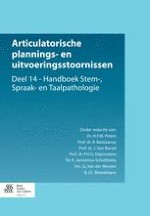
2014 | OriginalPaper | Hoofdstuk
Fonologische en articulatorische planningsstoornissen: modellen en vormen
maart 2006
Auteurs : Dr. H.F.M Peters, Prof.dr. R. Bastiaanse, Prof.dr. J. Van Borsel, Prof.dr. P.H.O. Dejonckere, Dr. K. Jansonius-Schultheiss, Drs. Sj. Van der Meulen, B.J.E. Mondelaers
Gepubliceerd in: Articulatorische plannings- en uitvoeringsstoornissen
Uitgeverij: Bohn Stafleu van Loghum